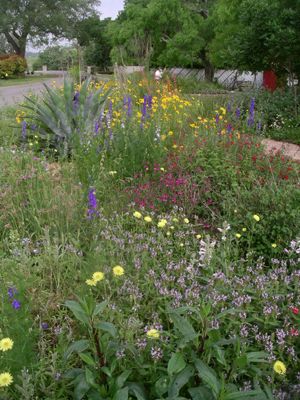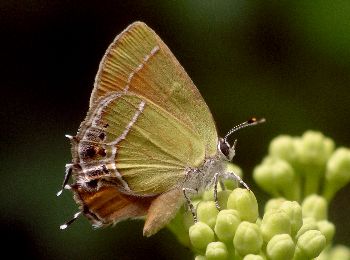April, 2013
Winnie's Gardens
by Valerie
Lots of people garden, some extensively so, but few create a habitat so well-suited to the locale that it requires no supplemental irrigation, so filled with diverse native plants that it accommodates multitudes of insects and other animals, and so pleasing to the eye that people driving by often stop for a closer look. Winnie's gardens are located in a typical suburban neighborhood in Manchaca, just south of Austin, TX. This area is prone to severe drought, flash flood producing rain events, scorching summers, and the occasional hard winter freeze. The native flora  includes numerous species capable of handling all these challenges. With tireless effort and creativity, Winnie turned a large expanse of mundane grass into a wonderland of blooms and their attendant animals, all capable of exploiting the varied ways in which this particular locale sustains life. Even the turf areas of her yard contain enough different kinds of plants that they harbor wildlife; to the casual viewer, it looks like ordinary lawn, but up close one finds tiny flowers, various low-growing plants, a number of different kinds of grasses, and animals such as lizards, grasshoppers, spiders, and moths.
includes numerous species capable of handling all these challenges. With tireless effort and creativity, Winnie turned a large expanse of mundane grass into a wonderland of blooms and their attendant animals, all capable of exploiting the varied ways in which this particular locale sustains life. Even the turf areas of her yard contain enough different kinds of plants that they harbor wildlife; to the casual viewer, it looks like ordinary lawn, but up close one finds tiny flowers, various low-growing plants, a number of different kinds of grasses, and animals such as lizards, grasshoppers, spiders, and moths.
How did a bit of rocky land with poor soil become a wildlife refuge? Winnie has spent years demonstrating that a yard can be more than just a decorative skirt around a house. It is possible to not only replicate the surrounding ecosystem but improve upon it, providing water, shelter and food for literally thousands of kinds of insects, spiders, and other animals. A couple of small re-circulating water features, bird baths, a feeder or two, lots of rocks, some good soil, and areas with decomposed granite create the foundation for a fascinatingly active and interrelated biome. Herbivorous animals, namely insects, feast on the abundant vegetation. These, in turn, are preyed upon by other insects, spiders, birds, lizards and snakes. Some of these hunters are themselves food for other predators, so the concept of a food chain becomes more like a food web, as various animals of all sizes find nutrition in whatever is their adapted manner. Scavengers that clean up the remains not only return nutrients to the soil but may themselves become a meal for yet another organism. An astute observer can find and witness the workings of our large environment within the confines of a single yard.
I first met Winnie in 2008 when I was regularly visiting and photographing at the Lady Bird Johnson Wildflower Center and she was a volunteer. I often chatted with the people working in the gardens and they had learned that I was keen on invertebrates. After Winnie several times suggesting that I might enjoy visiting her yard, and I always politely declining because I thought that I had plenty of other natural areas that already occupied my time, her persistence resulted in an exchange of emails and directions to Winnie's house in Manchaca. It only took one visit to get me hooked, and I have been returning to her yard once a week ever since. Winnie's subtle coaxing and tireless example of volunteering eventually influenced me to the point that I too joined the volunteers at the Wildflower Center. Her seemingly endless curiosity encouraged me to teach people about the tiny creatures that make up the vast majority of our wildlife, hence I started and continue to lead the Fauna Project, an ongoing effort to document the myriad species living within the
Gardens.
I might enjoy visiting her yard, and I always politely declining because I thought that I had plenty of other natural areas that already occupied my time, her persistence resulted in an exchange of emails and directions to Winnie's house in Manchaca. It only took one visit to get me hooked, and I have been returning to her yard once a week ever since. Winnie's subtle coaxing and tireless example of volunteering eventually influenced me to the point that I too joined the volunteers at the Wildflower Center. Her seemingly endless curiosity encouraged me to teach people about the tiny creatures that make up the vast majority of our wildlife, hence I started and continue to lead the Fauna Project, an ongoing effort to document the myriad species living within the
Gardens.
Although Winnie probably first had beautiful flower beds in mind when she began her yard's transformation, the idea of biodiversity in both plants and animals was there too. A riot of color is a good description of her gardens during much of the year. And the flowers are not the only sources of that splendor. Butterflies abound on any warm day. Taking the time to learn about host plants for caterpillars, Winnie has provided what is undoubtedly one of the premier butterfly nurseries in the area. By simply catering to one kind of insect, all the others, including bees, flies, dragonflies, beetles, etc., benefit. Avoiding pesticides insures that the natural balance between herbivorous insects and predators is allowed to continue undisturbed. Aphids, scale, and caterpillars of all types are present, but so are the wasps, assassin bugs, ladybird beetles, and other predators that keep them in check. Birds, living high on the food web, enjoy the abundant supply of insects that helps them successfully raise their broods every year.
Not only do I enjoy watching and photographing the insects and spiders that live in her gardens, but Winnie's passion for the environment makes talking with her a delight. We share some opinions about how we relate to the nature that surrounds us, including the belief that a plant which hasn't fed an animal is not doing its job, a weed is just a wildflower that is growing where we humans don't like it, a garden crowded with many kinds of plants is a happy place, and the more animal species, the merrier. Unless an insect, spider or plant directly offends us

A rare Xami Hairstreak that visited Winnie's gardens in 2012 |
(like a mosquito biting), then it's better to just live and let live. Winnie uses soapy water instead of pesticides to cut down the number of insects eating her Bluebonnets, and a concoction with vinegar rather than herbicides to help control the plants growing in the pathways of her garden. She is willing to permit even rather unattractive plants utilized by relatively overlooked insects a spot in her gardens, letting them grow unobtrusively amidst the more showy flowers that satisfy our human sensibilities.
Through drought periods, which happen with dismaying regularity around here, Winnie does not irrigate her yard or gardens. Manchaca has been under water use restrictions for awhile now, but that is not the only reason for her strong commitment to water conservation. She simply cares too much about the environment to waste a precious resource. She has a rain collection system, which she uses to replenish the water levels in her small fountains, and keeps gallon jugs handy in order to hand water newly transplanted flowers. In spite of the lack of sprinklers or other irrigation, much of her yard looks relatively lush and green, even during the worst heat of the summer. When cooler temperatures and rains prevail, it is positively verdant.
I never tire of making the trip to Manchaca to spend a couple of hours watching the wildlife against a backdrop of gorgeous plants. I am constantly finding species I've never seen before. Winnie's generous sharing of plants and seeds insures that the lovely flowers inhabiting her gardens will also grace yards all around Austin, while the bugs and other critters that they nourish will be safe from human intervention because Winnie has impressed upon everyone who will listen the importance of biodiversity and its relationship to a healthy environment.
 I might enjoy visiting her yard, and I always politely declining because I thought that I had plenty of other natural areas that already occupied my time, her persistence resulted in an exchange of emails and directions to Winnie's house in Manchaca. It only took one visit to get me hooked, and I have been returning to her yard once a week ever since. Winnie's subtle coaxing and tireless example of volunteering eventually influenced me to the point that I too joined the volunteers at the Wildflower Center. Her seemingly endless curiosity encouraged me to teach people about the tiny creatures that make up the vast majority of our wildlife, hence I started and continue to lead the Fauna Project, an ongoing effort to document the myriad species living within the
Gardens.
I might enjoy visiting her yard, and I always politely declining because I thought that I had plenty of other natural areas that already occupied my time, her persistence resulted in an exchange of emails and directions to Winnie's house in Manchaca. It only took one visit to get me hooked, and I have been returning to her yard once a week ever since. Winnie's subtle coaxing and tireless example of volunteering eventually influenced me to the point that I too joined the volunteers at the Wildflower Center. Her seemingly endless curiosity encouraged me to teach people about the tiny creatures that make up the vast majority of our wildlife, hence I started and continue to lead the Fauna Project, an ongoing effort to document the myriad species living within the
Gardens.
 includes numerous species capable of handling all these challenges. With tireless effort and creativity, Winnie turned a large expanse of mundane grass into a wonderland of blooms and their attendant animals, all capable of exploiting the varied ways in which this particular locale sustains life. Even the turf areas of her yard contain enough different kinds of plants that they harbor wildlife; to the casual viewer, it looks like ordinary lawn, but up close one finds tiny flowers, various low-growing plants, a number of different kinds of grasses, and animals such as lizards, grasshoppers, spiders, and moths.
includes numerous species capable of handling all these challenges. With tireless effort and creativity, Winnie turned a large expanse of mundane grass into a wonderland of blooms and their attendant animals, all capable of exploiting the varied ways in which this particular locale sustains life. Even the turf areas of her yard contain enough different kinds of plants that they harbor wildlife; to the casual viewer, it looks like ordinary lawn, but up close one finds tiny flowers, various low-growing plants, a number of different kinds of grasses, and animals such as lizards, grasshoppers, spiders, and moths.
